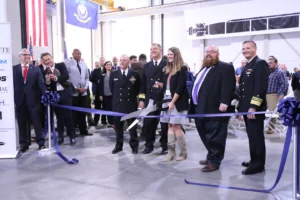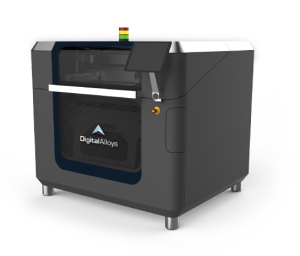The Program Executive officer for Strategic Submarines this week said improvements in metallic additive manufacturing (AM), or 3D printing, could lead to upward of an 80 percent reduction in the schedule to get components in new construction shipyards.
Speaking during a panel discussion Monday at the American Society of Naval Engineers’ Technology, Systems and Ships Symposium, Matt Sermon said the Navy is investing in the ability to produce heavy metal parts via additive manufacturing, especially in castings, forgings, fittings, valves and fasteners.
Sermon said there has been “tremendous progress” in metallic additive manufacturing in the last few years he expects will help deliver and sustain
Virginia-class attack submarines and Columbia-class ballistic missile submarines.

Noting the demand signal calls for one new Columbia-class submarine to be delivered every year with no margin, he said currently “we do not have the timely capacity” for that level of production, but that could be improved with AM.
He said the limitations on additive manufacturing are mostly tied to requiring more maturity in manufacturing readiness levels rather than technology readiness levels.
“The data analytics we’ve done, we’ve looked at about 5,500 parts that are scheduled challenges for new construction and sustainment, mostly for submarines, though we have a great data set from the surface community now, too, that we’re looking at. And we found essentially, there’s about six materials…that can count for about 70 percent of our links. And those are things that are heavy in ballast fittings and fasteners and take us back to casting and fittings type of metalwork,” Sermon said.
He said progress in metallic AM research so far has led to Navy, academia, applied, research, shipbuilding and other industry partners working on a “detailed plan to mature those six materials and have them ready for mainstream production by March of 2024.”
Sermon described this metallic AM research as moonshots and three projects in 2023 will be printing metallic AM parts “that a year ago we did not believe we were ready to print.”
He said the technical and technology community has convinced him there is still more work to do on a couple of the materials that involve steel alloys, but “that has not convinced me that we cannot do it, in fact, the opposite. And by March of 2024, it’s an aggressive goal…by March of 2024 we’ll be at maturity in those six materials, putting them on ships, submarines.”
Sermon argued if the supply chain transitions to increasing and relying on metallic AM parts production it could lead to between a 50 to 95 percent reduction in schedules for components at new construction shipyards.
“80 percent reduction in schedules for components that we need in shipyards, for components that we need in new construction is not unrealistic. It ranges from 90 or 95 percent reduction to 60 or 50 depending on machine…requirements and where we are in some technologies and machine efficiency right now. But in general, 80 percent is not out of the question,” he said.
Sermon also underscored the importance of the Navy’s new AM Center of Excellence in Danville, Va., co-located with the national training workforce pipeline efforts, which opened in October (Defense Daily, Oct. 6).
An unspecific number of additive manufacturing machines are located there and Sermon said now some of those AM-built parts and machines are being put on submarines.
“We have a number of machines that we’ve ordered, actually the first one is delivering…in late February. We’ll have a series delivered throughout the year.”
Previously, Austal USA announced it is leading the consortium of AM experts for the Navy, providing program management and oversight of development and production efforts. Sermon said this consortium is working to produce five of the six metallic parts that will start going on submarines later this year.

Sermon said the consortium is helping produce the five metallic part types soon to be ready to be out on submarines this year.
Also during the panel, Doug Arnold, director of Marine Engineering, NAVSEA 05Z, reiterated the service installed a metallic additive manufacturing machine aboard the USS Bataan (LHD-5), a Wasp-class amphibious assault ship in November. The machine is capable of producing 316L stainless steel, common on many ship systems as well as a second polymer-based 3-D printer (Defense Daily, Nov. 10)
“So we’re starting to roll out our metal AM capabilities.”
When comparing it to the storming, norming and performing cycle, “we’ve been in the storming for many years in AM. We’re now in the norming.”
Arnold said the service gathers AM machines it intends to put on ships at Naval Surface Warfare Center, Carderock Division. The service also has a lab there where they help develop technical data packages for ships at sea when sailors want to print a part to use on their ship.